Ayrshire Cows for Sale in Kenya (2025) – Best Dairy Breed Prices & Farms
- BeyondForest

- May 6
- 7 min read
Updated: 2 days ago

Ayrshire Cows have an approximately 4.0% butterfat and 3.2–3.5% protein, making it ideal for cheese and yogurt production.

Image of a Pure Ayrshire cow, on her 2nd lactation ,with a 3 weeks old Calf for sale by Delamere Farm
Ayrshire cows are a well-known dairy cattle breed that originated from Scotland and are now cherished worldwide for their excellent milk production, adaptability, and graceful appearance.
Known for their distinctive red-and-white coats, Ayrshires strike a balance between milk yield, efficiency, and hardiness, making them ideal for both small- and large-scale dairy farms.
Lactation is the period during which a cow produces milk after calving.
1st lactation starts after the cow gives birth to her first calf.
2nd lactation starts after the cow gives birth to her second calf, and so on

Image of a 7 months incalf Ayrshire By SEGO dairies
Ayrshire cows trace their roots to the County of Ayr in southwestern Scotland, where they were developed in the early 19th century. Originally, the local cattle were crossed with imported Dutch, Teeswater, and Channel Island breeds to enhance milk production and adaptability.
Dam = the mother of an animal (usually used in livestock breeding).
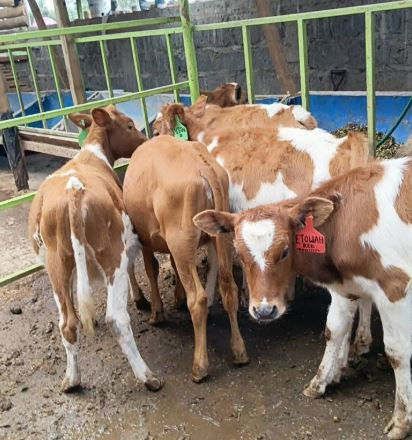
Image of 6 months old Ayrshires by Kimtai Evans
"In-calf" is just another term for "pregnant" in cattle
The breed was recognized as distinct in the late 1800s, with the Ayrshire Cattle Society being formed in Scotland to maintain its lineage. By the late 1800s, Ayrshires had been exported to other parts of Europe, North America, Australia, and Africa, including Kenya, where they remain among the most popular dairy breeds due to their hardiness and performance in varying climates.
With Most Farmers the pricing of Ayrshire Cows depends with size and calves
Searching for the Perfect Ayrshire Cow?
Whether you're looking for the ideal breed for milk production, need guidance on pricing, or want help with transport – we’ve got you covered!
Simply fill out the Google Form, and our team will get back to you with all the information you need.👉 Click here to get started!

Image of an Ayrshire Cow By Delamere Farm
A heifer is a young female cow that has not yet given birth to a calf or has not calved yet
A cow is a female that has given birth (usually used for dairy production)
Ayrshires are medium-sized cows with several distinctive features Red and white color as red may range from deep cherry to mahogany or even orange. The pattern varies widely. Mature cows weigh between 450–600 kg, and bulls can weigh up to 1,000 kg. They typically have a clean-cut head with upward-curving horns, although many are dehorned.
When a cow is said to be on its 2nd lactation, it means that she is going through her second cycle of milk production after having given birth to her second calf.
3 months old Red Friesian Ayrshire Calf | 40,000Ksh |
Super pedigree Ayrshire calf 5 months old | 55,000Ksh |
Super giant pedigree Ayrshire | 225,000Ksh |
Pedigree 6 months old Ayrshire | 45,000Ksh |
Ayrshire cows with 1month incalf, 7months incalf and 3 months incalf. | 90,000Ksh |
5 months incalf ayrshire currently doing 23 litres per day | 160,000Ksh |
Ayrshire 7.5 Months Incalf Heifer | 150,000Ksh |
When a cow is said to be "6.5 months in-calf," it means she is 6.5 months pregnant—that is, 6 and a half months into her gestation period.

Image of a High Quality Ayrshire heifer on sale for 80,000Ksh with 6.5 months IN calf by Tarus
Searching for the Perfect Ayrshire Cow?
Whether you're looking for the ideal breed for milk production, need guidance on pricing, or want help with transport – we’ve got you covered!
Simply fill out the Google Form, and our team will get back to you with all the information you need.👉 Click here to get started!
Ayrshire Cows Price List Online
Cows in their 2nd lactation are generally more mature and produce more milk than in their 1st lactation.

Image of an Ayrshire cow by Kimani James on Facebook
Pure Ayrshire cow, on 2nd lactation | 65,000Ksh |
7 months in- calf Ayrshire | 90,000Ksh |
6 months old Ayrshires | 45,000Ksh |
Quality Ayrshire Heifer with 6.5 month In calf | 80,000Ksh |
Ayrshire 3 months in calf | 70,000Ksh |
13month old Ayrshire heifer | 60,000Ksh |
Common breeds crossed with Ayrshire might include Friesian, Holstein, Jersey, or local dairy breeds, depending on the breeding goals.
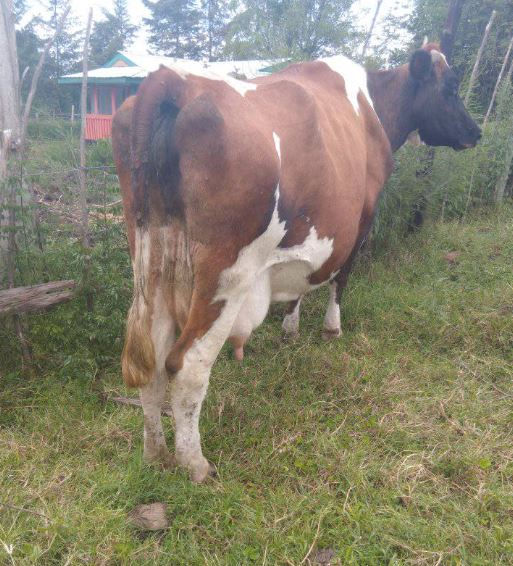
Image of a High Quality Ayrshire 8.5 months in calf producing 25 litres by Wesly
Ayrshire Feeding and Nutrition
Knowing a cow's lactation number helps farmers manage nutrition, health, and breeding plans.
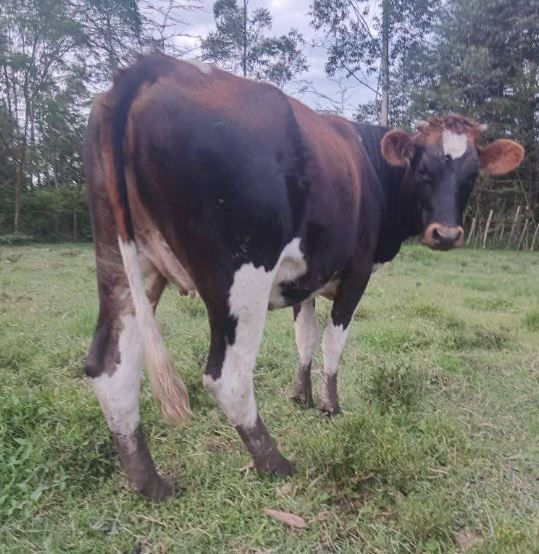
Image of a Quality cross Ayrshire 6 months incalf for sale by Wesly
Ayrshires require a balanced diet of roughage and concentrates to maintain milk production and body condition. Key feeding considerations include Roughage such as Napier grass, hay, maize stover, and silage form the bulk of their diet. Concentrates such as Dairy meal, maize bran, cottonseed cake, sunflower cake, and mineral supplements and Water A lactating Ayrshire can consume up to 80–100 liters of water per day, especially in hot climates. Proper feeding influences not only milk yield but also fertility, calf growth, and resistance to disease.
Cross Ayrshire means the cow is not purebred Ayrshire, but is a crossbreed—i.e., it has Ayrshire and another breed in its genetic makeup.
Ayrshire Milk Production Performance

Image of a Quality Ayrshire 3 months incalf for sale at sotik tebwo location by Wesly
Ayrshires are valued primarily for their milk production efficiency. Here’s what makes their milk stand out Average yield is between 20–30 liters per day under proper feeding and management, with high-yielding cows producing up to 6,000–7,000 liters per lactation.
Calf management tips for Ayrshire include feeding colostrum within the first 2 hours, Providing clean, and dry bedding, Dehorning early (2–3 weeks) and start feeding calf starter from 2 weeks of age Wean between 8–12 weeks, depending on growth
Advantages of Ayrshire Cows
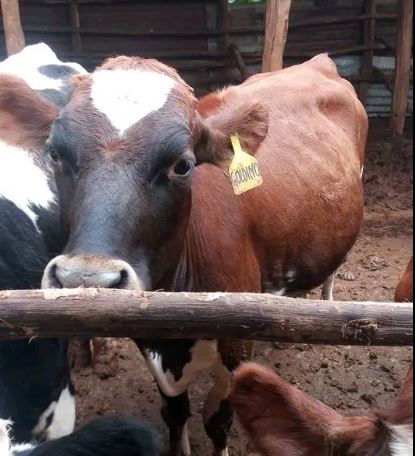
Image of a 13month old heifer by Rotich Dairy
Hardiness and Adaptability
Ayrshires are known for their ability to adapt to different climates, including hot or cold environments. Their strong legs and hooves allow them to graze long distances and handle rough terrain, making them well-suited for zero-grazing, semi-intensive, and free-range systems.
Longevity and Fertility
They have a long productive life, often calving regularly for 8–10 years or more. Their calving interval is typically 12–14 months, and they are good breeders with fewer reproductive problems than some high-producing breeds.
Searching for the Perfect Ayrshire Cow?
Whether you're looking for the ideal breed for milk production, need guidance on pricing, or want help with transport – we’ve got you covered!
Simply fill out the Google Form, and our team will get back to you with all the information you need.👉 Click here to get started!
Ease of Management
Ayrshires are Less prone to lameness they are easier to milk, Less susceptible to metabolic disorders like milk fever and their balanced temperament also contributes to easier handling and training, especially in smallholder settings.
Good Grazers
Due to their lighter body weight compared to Friesians or Holsteins, Ayrshires place less pressure on pasture. This trait makes them ideal for pasture-based systems and rotational grazing.
How much Milk can a Ayrshire Cow Produce
An Ayrshire cow typically produces 6,000 to 8,000 liters of milk per lactation, which lasts about 305 days. Under good management and nutrition, high-performing Ayrshires can exceed 9,000 liters. Their milk is known for excellent quality, with an average butterfat content of 4.0% and protein around 3.3%, making it ideal for cheese production. These cows are efficient grazers and adapt well to different climates and farming systems.
A bull is a male that can breed (not castrated)
A Steer is a castrated male (raised for meat)
A Calf is a baby cow (male or female)
Ayrshire cows may be more temperamental than other dairy breeds, making handling challenging Additionally, they require good pasture or feed quality to perform optimally and may not thrive in poor management systems.
Ayrshires originate from Scotland and are medium-sized, known for producing moderate volumes of high-quality milk with around 4.0% butterfat and 3.3% protein, ideal for cheese. Friesians, from the Netherlands, are larger and produce higher milk volumes, often exceeding 9,000 liters per lactation, but with lower butterfat content (around 3.5%). Friesians are more common in commercial dairy farms due to their high yield, while Ayrshires are favored in systems valuing milk solids and grazing efficiency.
Searching for the Perfect Ayrshire Cow?
Whether you're looking for the ideal breed for milk production, need guidance on pricing, or want help with transport – we’ve got you covered!
Simply fill out the Google Form, and our team will get back to you with all the information you need.👉 Click here to get started!
What is Special About Ayrshire Milk
Ayrshire milk is special for its high quality and balanced composition, with approximately 4.0% butterfat and 3.3% protein, making it excellent for cheese and yogurt production. It also has a smooth texture and rich flavor.
What is Ayrshire Known For
Ayrshire is known for its hardy and efficient dairy cows, which thrive in various climates and pasture-based systems. Originating from Scotland, the breed is valued for producing high-quality milk with excellent butterfat and protein content.
Ayrshire cow interesting facts
Ayrshires generally have few calving problems, making them great for breeding.
Ayrshire cows originated in Ayrshire, Scotland, in the 1700s.
They have unique red and white markings, with no two cows looking exactly alike.
Ayrshires milk is ideal for cheese and yogurt due to its balanced butterfat and protein.
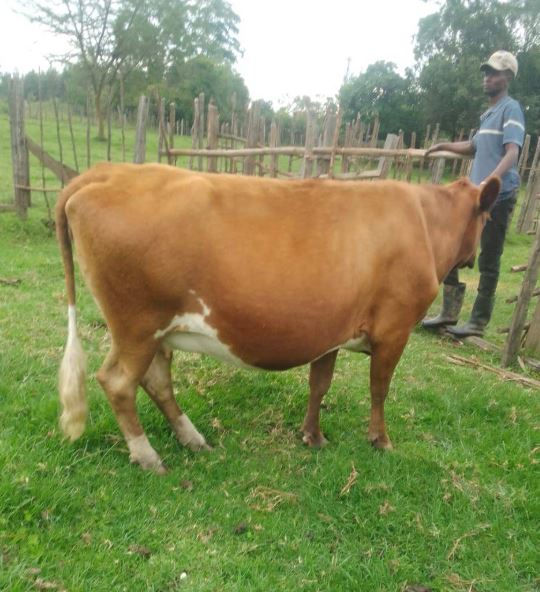
Image of a High Quality Ayrshire 7 months incalf for sale by Wesly at Sotik
Ayrshires reach maturity around 14 to 16 months and can be bred once they weigh around 300–350 kg. Breeding options include Artificial Insemination (AI) which is Preferred for genetic improvement and disease control. Natural Mating is Viable where AI services are unavailable. To improve genetic performance, farmers often use AI with high-quality bulls to select for traits like milk yield, udder conformation, and disease resistance.
Ayrshires are known for easy calving due to their pelvic structure and moderate calf size.
Due to their high value there seem to be a syndicate because once the Ayshire are stolen they ferry the cows using a pick-up or lorry as some farmers will atleast to it that marks ya Lorry or pick up tyres are present . One major way to curb this would be Livestock insurance and radio trackers. They work and though can be expensive for a reason install some CCTV Camera System for you? This should offer some security in future

Image of a Post on X by Kanda over Ayrshire Cow Theft





Comments